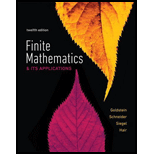
Concept explainers
First Paradox: Under certain circumstances, you have your best chance of winning a tennis
tournament if you play most of your games against the best possible opponent.
Alice and her two sisters, Betty and Carol, are avid tennis players. Betty is the best of the three sisters, and Carol plays at the same level as Alice. Alice defeats Carol 50% of the time but only defeats Betty 40% of the time.
Alice’s mother offers to give her $100 if she can win two consecutive games when playing three alternating games against her two sisters. Since the games will alternate, Alice has two possibilities for the sequence of opponents. One possibility is to play the first game against Betty, followed by a game with Carol, and then another game with Betty. We will refer to this sequence as BCB. The other possible sequence is CBC.
Calculate the probability of Alice getting the $100 reward if she chooses the sequence BCB.
Want to see the full answer?
Check out a sample textbook solution
Chapter 6 Solutions
Finite Mathematics & Its Applications (12th Edition)
- Consider the following vector field v^-> (x,y): v^->(x,y)=2yi−xj What is the magnitude of the vector v⃗ located in point (13,9)? [Provide your answer as an integer number (no fraction). For a decimal number, round your answer to 2 decimal places]arrow_forwardQuestion 4 Find the value of the first element for the first row of the inverse matrix of matrix B. 3 Not yet answered B = Marked out of 5.00 · (³ ;) Flag question 7 [Provide your answer as an integer number (no fraction). For a decimal number, round your answer to 2 decimal places] Answer:arrow_forwardQuestion 2 Not yet answered Multiply the following Matrices together: [77-4 A = 36 Marked out of -5 -5 5.00 B = 3 5 Flag question -6 -7 ABarrow_forward
- Question 3 Not yet answered Marked out of 5.00 Flag question What is the angle between the two vectors: v1 = 12i + 9j and v2 = 9i + 12j [Write your answer in degrees between 0 and 360] [Provide your answer as an integer number (no fraction). For a decimal number, round your answer to 2 decimal places] Answer:arrow_forwarddw z = Find using direct dt If w = + x = (cost), y = (sint), z= substitution and chain rule methods.arrow_forwardSolve thisarrow_forward
- Hi can you find the answers to unit 21 review questions in Delmar's standard textbook of electricityarrow_forwardNot use ai pleasearrow_forwardDerive the projection matrix for projecting vectors onto a subspace defined by given basis vectors. • Verify that the projection matrix is idempotent and symmetric. • Compute the projection of a specific vector and check your result step-by-step. Link: [https://drive.google.com/file/d/1wKSrun-GlxirS3IZ9qoHazb9tC440AZF/view?usp=sharing]arrow_forward
 Big Ideas Math A Bridge To Success Algebra 1: Stu...AlgebraISBN:9781680331141Author:HOUGHTON MIFFLIN HARCOURTPublisher:Houghton Mifflin Harcourt
Big Ideas Math A Bridge To Success Algebra 1: Stu...AlgebraISBN:9781680331141Author:HOUGHTON MIFFLIN HARCOURTPublisher:Houghton Mifflin Harcourt
